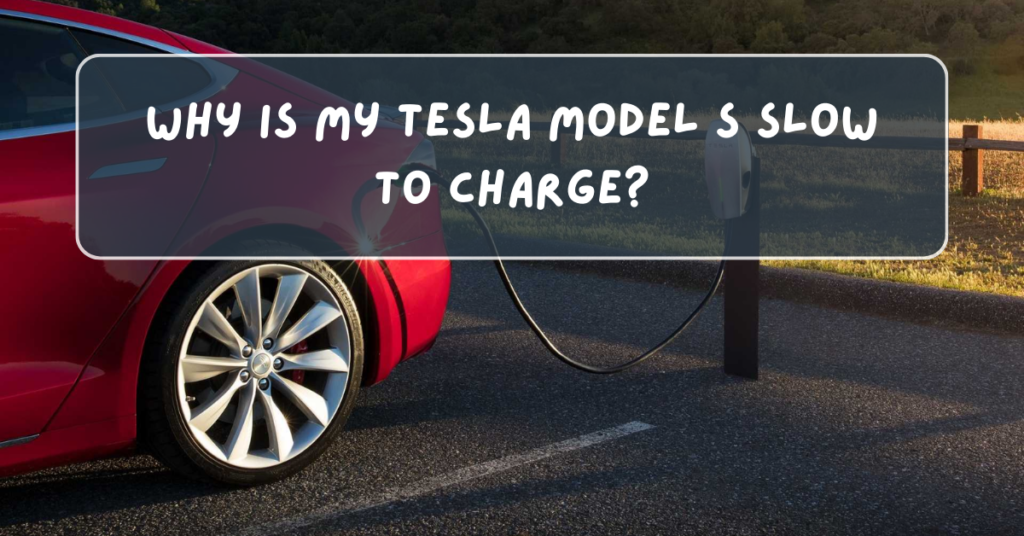
It’s frustrating when you’re eagerly waiting for your Tesla Model S to charge, but the process seems to be taking forever. Charging speeds can vary depending on several factors, and understanding why your Tesla Model S is charging slowly is essential to solving the issue. Whether you’re charging at home, at a Supercharger station, or at a public charging station, this guide will walk you through the common reasons your Model S might be charging slowly and how you can fix it.
Common Causes of Slow Charging in Tesla Model S
Before troubleshooting, it’s important to understand some common reasons that could be contributing to slow charging speeds:
- Charging Source: The type of charger you’re using plays a big role in how quickly your Tesla Model S charges. Charging at home using a standard 110V outlet, for example, will charge much slower than using a dedicated Tesla Wall Connector or a Supercharger station.
- Battery Health: Over time, your Tesla’s battery may lose its ability to charge quickly due to wear and tear.
- Environmental Factors: Cold weather and high temperatures can slow down charging speeds.
- Settings and Software: Certain settings or software updates can limit charging speed.
- Charging Port Issues: Dirt or debris in the charging port can cause charging problems.
Let’s dive into how you can address these issues.
Step-by-Step Troubleshooting for Slow Charging in Your Tesla Model S
1. Check Your Charging Source
The most common cause of slow charging is the charging source itself. Depending on where you are charging, the speed can vary significantly.
- At Home (120V Outlet):
- What You Can Do: Charging from a standard 120V outlet is extremely slow and usually provides around 3-5 miles of range per hour. If you’re charging at home, consider upgrading to a 240V outlet or installing a Tesla Wall Connector for faster charging.
- At Home (240V Outlet):
- What You Can Do: This type of outlet will charge your Model S much faster than the standard 120V. A typical 240V outlet will provide between 20-30 miles of range per hour. If you’re using a 240V outlet and still experiencing slow charging, make sure your electrical system is capable of supporting the charging speed.
- Supercharging:
- What You Can Do: Tesla Superchargers can charge your Model S quickly, typically providing up to 170 miles of range in just 30 minutes. If you’re charging at a Supercharger and it’s taking longer than expected, check the charging station for any issues or congestion.
2. Assess Battery Temperature and Health
Cold temperatures can slow down charging speeds, especially if the battery is too cold to charge efficiently. Additionally, as batteries age, they can lose some of their charging capacity.
- What You Can Do:
- In cold weather, consider pre-conditioning your battery by using the “Preheat” option on your Tesla app. This warms up the battery and allows for faster charging.
- Check your car’s battery health through the Tesla app or vehicle settings. If the battery is significantly degraded, it may be time to have it inspected or replaced.
3. Software Limitations and Settings
Tesla periodically releases software updates that can impact charging performance. Additionally, certain settings may limit how fast the car charges.
- What You Can Do:
- Ensure your Tesla software is up-to-date by checking for updates in the ‘Software’ tab on the touchscreen.
- Check your charging settings to ensure that you’re not limiting the maximum charging speed. For example, if you’ve set a lower charge limit (like 80%), the car may charge more slowly to preserve battery health.
- Enable “Scheduled Charging” during off-peak hours, as Tesla sometimes limits charging speed during peak times to optimize grid usage.
4. Examine the Charging Cable and Port
A damaged or worn-out charging cable can reduce charging efficiency, as can dirt or debris in the charging port.
- What You Can Do:
- Inspect the charging cable for any visible damage, such as fraying or broken connectors.
- Clean the charging port and cable connector using a dry, clean cloth to ensure there’s no debris preventing a good connection.
- If you’re using a third-party charger, make sure it’s compatible with your Tesla Model S and is delivering the correct power output.
5. Charging Station Issues
Sometimes the issue isn’t with your car, but with the charging station you’re using. Tesla Superchargers and third-party stations may have technical difficulties that cause slower-than-usual charging speeds.
- What You Can Do:
- If you’re at a Supercharger, check the charging station’s status via the Tesla app to see if there are any ongoing issues.
- Try switching to another stall if one is available, as some stalls may be slower or malfunctioning.
- If you’re using a public charging station, ensure the station is functioning correctly. You can try using a different station to see if the issue persists.
Conclusion
If your Tesla Model S is charging slowly, don’t panic! There are many factors that could be causing the problem, but most of them are simple to troubleshoot and fix. Start by checking your charging source, battery health, and any software settings that may be limiting speed. If all else fails, reach out to Tesla support for further assistance. By following the steps outlined above, you can get back to fast, efficient charging in no time.